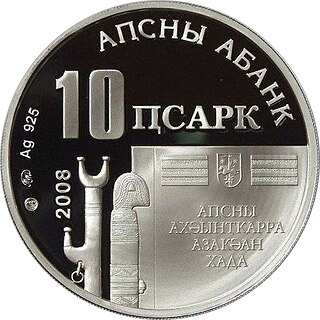 W
WThe apsar is a currency of Abkhazia. So far, only coins in denominations of 1, 2, 10, 20, 25, 50, and 100 apsars and banknote for 500 apsars have been issued. While the coins are legal tender in the Republic of Abkhazia, their usage is very limited, and the coins are mostly made for collectors. In Abkhazia, the Russian ruble is used in practice. The first apsar coins were introduced in 2008.
 W
WThe Artsakh dram is a monetary unit of the de facto independent Republic of Artsakh. Although it is legal tender, it is not as widely used as the Armenian dram.
 W
WThe dinar is the currency of Bahrain. It is divided into 1000 fils (فلس). The Bahraini dinar is abbreviated د.ب (Arabic) or BD (Latin). It is usually represented with three decimal places denoting the fils.
 W
WThe Dollar has been the currency of Barbados since 1935. The present dollar has the ISO 4217 code BBD and is normally abbreviated with the dollar sign "$" to distinguish it from other dollar-denominated currencies. It is divided into 100 cents.
 W
WThe Belarusian ruble or rouble is the official currency of Belarus. The ruble is subdivided into 100 copecks.
 W
WThe Belize dollar is the official currency in Belize. It is normally abbreviated with the dollar sign $, or alternatively BZ$ to distinguish it from other dollar-denominated currencies.
 W
WThe ngultrum is the currency of the Kingdom of Bhutan. It is subdivided into 100 chhertum. The Royal Monetary Authority of Bhutan is the minting authority of the ngultrum banknotes and coins. The ngultrum is currently pegged to the Indian rupee at parity.
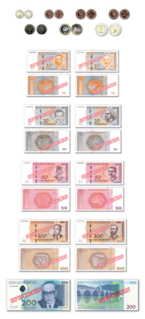 W
WThe Bosnia and Herzegovina convertible mark is the currency of Bosnia and Herzegovina. It is divided into 100 Pfenigs or Fenings and locally abbreviated KM.
 W
WThe Brunei dollar, has been the currency of the Sultanate of Brunei since 1967. It is normally abbreviated with the dollar sign $, or alternatively B$ to distinguish it from other dollar-denominated currencies. It is divided into 100 sen (Malay) or cents (English). The Brunei dollar is issued by the Autoriti Monetari Brunei Darussalam.
 W
WThe lev is the currency of Bulgaria. In old Bulgarian the word "lev" meant "lion", the word 'lion' in the modern language is lаv. The lev is divided in 100 stotinki. Stotinka in Bulgarian means "a hundredth" and in fact is a translation of the French term "centime". Grammatically the word "stotinka" comes from the word "sto" (сто) - a hundred.
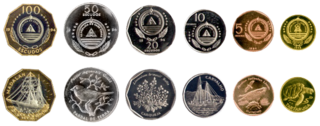 W
WThe escudo is the currency of the Republic of Cape Verde.
 W
WThe Central African CFA franc is the currency of six independent states in Central Africa: Cameroon, Central African Republic, Chad, Republic of the Congo, Equatorial Guinea and Gabon. These six countries have a combined population of 55.2 million people, and a combined GDP of US$113.322 billion.
 W
WThe CFA franc is the name of two currencies, the West African CFA franc, used in eight West African countries, and the Central African CFA franc, used in six Central African countries. Both currencies are guaranteed by the French treasury. Although separate, the two CFA franc currencies have always been at parity and are effectively interchangeable. The ISO currency codes are XAF for the Central African CFA franc and XOF for the West African CFA franc. On 22 December 2019, it was announced that the West African currency would be replaced by an independent currency to be called Eco.
 W
WThe Cook Islands dollar was the former currency of the Cook Islands, which now uses the New Zealand dollar, although some physical cash issued for the Cook Islands dollar remains in use. The dollar was subdivided into 100 cents, with some older 50-cent coins carrying the denomination as "50 tene".
 W
WThe krone is the official currency of Denmark, Greenland, and the Faroe Islands, introduced on 1 January 1875. Both the ISO code "DKK" and currency sign "kr." are in common use; the former precedes the value, the latter in some contexts follows it. The currency is sometimes referred to as the Danish crown in English, since krone literally means crown. Historically, krone coins have been minted in Denmark since the 17th century.
 W
WThe Djiboutian franc is the currency of Djibouti. Its ISO 4217 currency code is DJF. Historically, it was subdivided into 100 centimes.
 W
WThe nakfa is the currency of Eritrea and was introduced on 8 November 1997 to replace the Ethiopian birr at par. The currency takes its name from the Eritrean town of Nakfa, site of the first major victory of the Eritrean War of Independence. The nakfa is divided into 100 cents.
 W
WThe pound is the currency of Guernsey. Since 1921, Guernsey has been in currency union with the United Kingdom and the Guernsey pound is not a separate currency but is a local issue of banknotes and coins denominated in pound sterling, in a similar way to the banknotes issued in Scotland, England and Northern Ireland. It can be exchanged at par with other sterling coinage and notes.
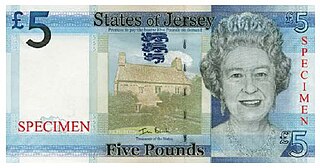 W
WThe pound is the currency of Jersey. Jersey is in currency union with the United Kingdom, and the Jersey pound is not a separate currency but is an issue of banknotes and coins by the States of Jersey denominated in pound sterling, in a similar way to the banknotes issued in Scotland and Northern Ireland. It can be exchanged at par with other sterling coinage and notes.
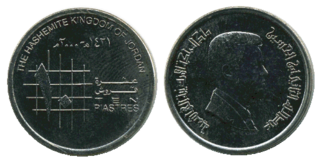 W
WThe Jordanian dinar has been the currency of Jordan since 1950. The dinar is divided into 10 dirhams, 100 qirsh or 1000 fulus. It is pegged to the US dollar.
 W
WThe Australian dollar is the official currency of Kiribati. The Kiribati coins are pegged at 1:1 ratio to the Australian dollar. Coins were issued in 1979 and circulate alongside banknotes and coins of the Australian dollar. Kiribati coins are nowadays very few in comparison to Australian coins, the last minor emission has been made in 1992, and these old coins are generally collected. The complete emissions of coins were made in 1979 and in 1989 for the tenth anniversary of independence.
 W
WThe Kuwaiti dinar is the currency of Kuwait. It is sub-divided into 1,000 fils.
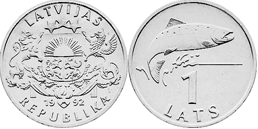 W
WThe lats was the currency of Latvia from 1922 until 1940 and from 1993 until it was replaced by the euro on 1 January 2014. A two-week transition period during which the lats was in circulation alongside the euro ended on 14 January 2014. It is abbreviated as Ls and was subdivided into 100 santīmi.
 W
WThe Lebanese pound is the currency of Lebanon. It was formerly divided into 100 piastres but because of high inflation during the Lebanese Civil War (1975–1990) the use of subdivisions was discontinued.
 W
WThe Lithuanian litas (ISO currency code LTL, symbolized as Lt; plural litai or litų was the currency of Lithuania, until 1 January 2015, when it was replaced by the euro. It was divided into 100 centų. The litas was first introduced on 2 October 1922 after World War I, when Lithuania declared independence and was reintroduced on 25 June 1993, following a period of currency exchange from the ruble to the litas with the temporary talonas then in place. The name was modeled after the name of the country. From 1994 to 2002, the litas was pegged to the U.S. dollar at the rate of 4 to 1. The litas was pegged to the euro at the rate of 3.4528 to 1 since 2002. The euro was expected to replace the litas by 1 January 2007, but persistent high inflation and the economic crisis delayed the switch. On 1 January 2015 the litas was switched to the euro at the rate of 3.4528 to 1.
 W
WThe Macau pataca or Macanese pataca is the currency of the Macau Special Administrative Region of the People's Republic of China. It is subdivided into 100 avos, with 10 avos called ho (毫) in Cantonese. The abbreviation MOP$ is commonly used.
 W
WThe Maldivian rufiyaa is the currency of the Maldives. The issuance of the currency is controlled by the Maldives Monetary Authority (MMA). The most commonly used symbols for the rufiyaa are MVR and Rf. The ISO 4217 code for Maldivian rufiyaa is MVR. The rufiyaa is subdivided into 100 laari.
 W
WThe Moroccan dirham is the official monetary currency of Morocco. It is issued by the Bank Al-Maghrib, the central bank of Morocco. One Moroccan dirham is subdivided into 100 centimes (cents).
 W
WThe Namibian dollar has been the currency of Namibia since 1993. It is normally abbreviated with the dollar sign $, or alternatively N$ to distinguish it from other dollar-denominated currencies. It is divided into 100 cents.
 W
WThe Netherlands Antillean guilder is the currency of Curaçao and Sint Maarten, which until 2010 formed the Netherlands Antilles along with Bonaire, Saba, and Sint Eustatius. It is subdivided into 100 cents. The guilder was replaced by the United States dollar on 1 January 2011 on Bonaire, Saba and Sint Eustatius. On Curaçao and Sint Maarten, the Netherlands Antillean guilder was proposed to be replaced by a new currency, the Caribbean guilder, but this was stalled indefinitely by negotiations over the establishment of a separate central bank for Curaçao. In November 2020, the Central Bank announced the introduction of the replacement guilder, which would have been implemented in the first half of 2021, but it was delayed.
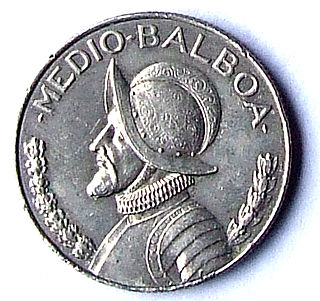 W
WThe balboa is, along with the United States dollar, one of the official currencies of Panama. It is named in honor of the Spanish explorer/conquistador Vasco Núñez de Balboa. The balboa is subdivided into 100 centésimos.
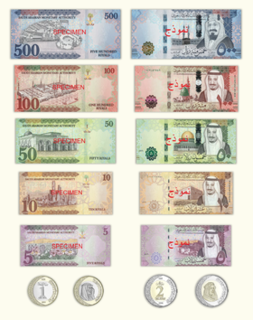 W
WThe Saudi riyal ; is the currency of Saudi Arabia. It is abbreviated as ر.س or SAR (Saudi Arabian Riyal) or ﷼. It is subdivided into 100 halalas.
 W
WThe sterling area was a group of countries that either pegged their currencies to the pound sterling, or actually used the pound as their own currency.
 W
WThe lilangeni is the currency of Eswatini and is subdivided into 100 cents. It is issued by the Central Bank of Eswatini. Similarly in situation to the Lesotho loti, there are singular and plural abbreviations, namely L and E, so where one might have an amount L1, it would be E2, E3, or E4.
 W
WThe Trinidad and Tobago dollar is the currency of Trinidad and Tobago. It is normally abbreviated with the dollar sign $, or alternatively TT$ to distinguish it from other dollar-denominated currencies. It is subdivided into 100 cents. Cents are abbreviated with the cent sign ¢, or TT¢ to distinguish from other currencies that use cents. Its predecessor currencies are the Trinidadian dollar and the Tobagonian dollar.
 W
WThe United Arab Emirates dirham, also known as simply the Emirati dirham, is the currency of the United Arab Emirates. The term dirham is officially abbreviated "AED", while unofficial abbreviations include "DH" or "Dhs.". The dirham is subdivided into 100 fils (فلس).
 W
WThe West African CFA franc is the currency of eight independent states in West Africa: Benin, Burkina Faso, Guinea-Bissau, Ivory Coast, Mali, Niger, Senegal and Togo. These eight countries had a combined population of 105.7 million people in 2014, and a combined GDP of US$128.6 billion.